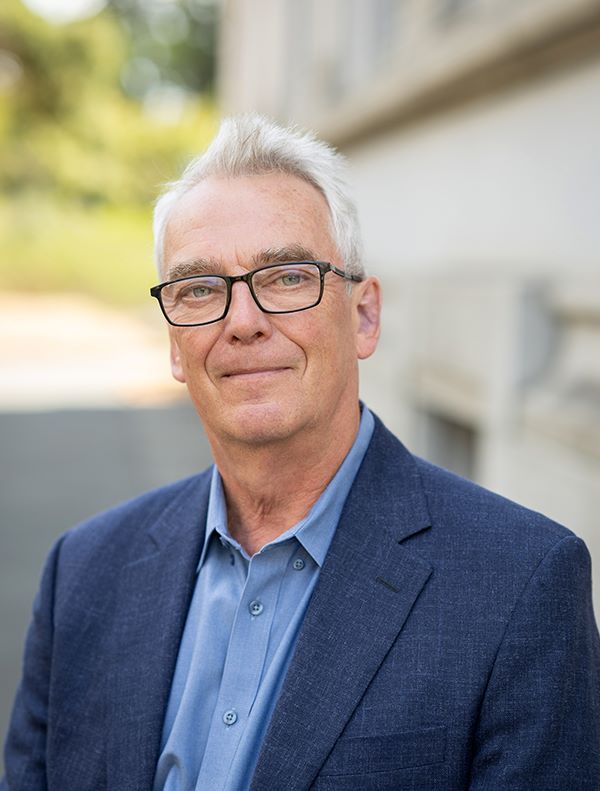A Collaborative Perspective:
Meet MCB’S New Dean, Richard Harland
By Kirsten Mickelwait

Last September, upon the retirement of his predecessor, Michael Botchan, Richard Harland assumed the office of MCB’s new dean. A professor of molecular and cell biology since 1984, he’d held the position of interim dean since July and had served as senior associate dean since 2016. He also previously served two stints as chair of the Department of Molecular and Cell Biology and head of the Division of Genetics, Genomics, Evolution, and Development.
What made him take on this added responsibility now? “I’m coming to the end of my career, and I thought it would be a great capstone to take on a new challenge,” he says. “In my previous roles, I'd learned a lot about how things work here at MCB. I thought it would be exciting to try and maintain—or even improve—the quality and excellence of our academic programs and research.”
The appointment was well received across campus. “Professor Harland’s decades of experience within Berkeley and his scientific achievements, including his election to the National Academy of Sciences and as a fellow of the Royal Society of London, underscore his capacity to elevate the division’s global reputation,” said UC Berkeley’s Chancellor Rich Lyons. “His leadership style—rooted in collaboration, mentorship and a light touch—has earned him the respect of his colleagues across the university.”
In his three-year term that lies ahead, Harland’s top priority is simply to recruit and retain the finest faculty at MCB. “If we have the best faculty, then the best graduate students will also want to come here,” he says. “Undergraduates will want to attend this wonderful, competitive university, and our undergraduate researchers will have the chance to excel. So at the heart of my mission is to maintain the academic excellence and broad access of this institution, both to Californians and to out-of-state students.”
Since arriving at UC Berkeley as a new faculty member forty years ago, Harland has been passionate about his own research studying evolution and early developmental biology—largely working with frog embryos.
Not only can we use models like the frog to learn more about the principles behind how an egg becomes a complicated organism, he says, but the amphibian vertebrates are a fairly easy subject to study. Their eggs can be acquired in large numbers, the embryos are big enough to be easily manipulated, and pieces of them can be transplanted to see where the important molecular signaling centers are.
“My goal, since I first came to Berkeley, has been to understand what molecules, genes, and proteins drive this process,” he says. “I’ve been extraordinarily lucky to arrive on the scene after the recombinant DNA revolution, and we’re advancing this knowledge, learning what genes do to organize the embryo.” Which are the molecules that are activated in regions of the egg that make the difference between the head and the tail, for example, or between the nervous system and the skin?
Signaling processes tend to get used over and over again, he explains, and are a trait that frogs share with humans. For example, one of the molecules that directs the formation of the frog’s nervous system is also used to determine the amount of bone that later forms in an adult. In 1992, Harland’s lab, along with that of William C. Smith, discovered the noggin (NOG) protein that’s involved in the development of many human body tissues, including bones, muscles, and nerve tissue. Noggin is a signaling molecule that helps promote somite patterning in the developing embryo. Later experiments in mice demonstrated that it also plays a role in neural tube fusion, learning, and cognition.
As for any translational impacts of his work, Harland says, “I'm unashamedly fundamental science-driven. I want to learn how things work.” That said, his lab has had a fruitful collaboration with Regeneron Pharmaceuticals, a partnership that further studied the noggin molecule and led to the formation of a research group working on preventing such diseases as Fibrodysplasia Ossificans Progressiva (FOP), a condition that turns connective tissues to bone.
Harland tries to spend an hour or two each day in his lab but, with his added role as dean, he’s learning to rely heavily on his excellent lab group to advance the rate of discovery. “I'm discovering that there are a lot of meetings when you're a dean,” he laughs, “and a lot of emails. I'm not going to tell my postdocs what to do; they know what's interesting, and they're going to create their own experiments. I get to enjoy it all vicariously.”
As for his mission as dean to attract the highest-caliber faculty to MCB, he’s found that the best method is to conduct both broad and targeted searches to find the talented scientists who are going to be making the next great discoveries. “This has happened again and again,” he says. “We've done a broad search, and we've identified some brilliant faculty members whose work is so exciting that we hire them to see how they’ll apply their brilliance to that particular problem.”
The fact that Berkeley is located in the Bay Area, with neighboring intellectual powerhouses like Stanford, UCSF, UC Davis, and the biotech industry, is an asset in the search process. Such surrounding talent enables MCB to recruit faculty who may be part of a scientific duo looking for two jobs. This vibrant culture of discovery is a huge draw at every level, from students to postdocs to faculty members.
The other major draw is MCB’s well-earned reputation for collaborative research, both within the department and across campus. This is a characteristic shared not only by faculty but by graduates and undergraduates as well. “I used to go away for the summer to teach a course at Woods Hole, Massachusetts,” Harland recalls, “and I'd come back to find that some new collaboration had been started by my students. It's just great to see that happening. I’m seeing them fostering collaboration just as much, if not more, than the faculty do.”
Such a collaborative perspective is characteristic of Harland’s leadership style as dean. “I think it's a mistake for leaders in general to think that they're the smartest people in the room,” he smiles.
Back to Main Spring 2025 Newsletter Page





